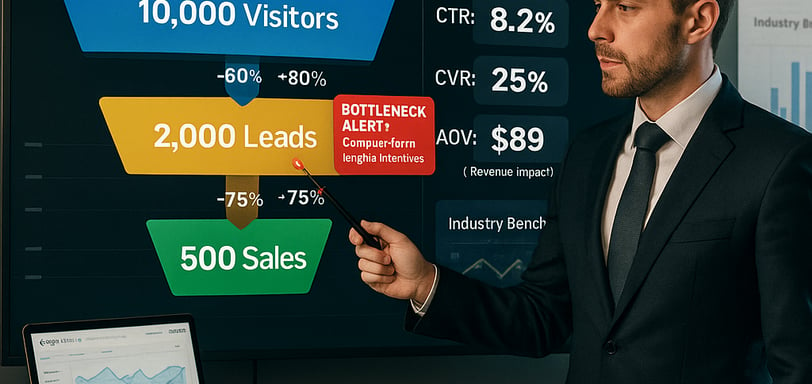Understanding Sales Funnel Analytics: Key Metrics to Boost Conversion Rates
Master the art of sales funnel analytics to identify bottlenecks, optimize performance, and skyrocket your e-commerce conversion rates.
MARKETING AUTOMATION
6/5/20253 min read


Introduction
In the competitive world of e-commerce, data is your most powerful ally. Sales funnel analytics provides the insights you need to understand how customers interact with your brand, identify bottlenecks, and optimize your funnel for maximum conversions.
But with so many metrics to track, it can be overwhelming to know where to start. In this article, we’ll break down the key metrics you need to monitor in your sales funnel analytics and show you how to use them to boost your conversion rates.
What is Sales Funnel Analytics?
Sales funnel analytics is the process of tracking and analyzing the performance of your sales funnel at each stage. It involves measuring key metrics to understand where customers are dropping off, what’s working, and what needs improvement.
By leveraging these insights, you can make data-driven decisions that enhance your funnel’s performance and drive higher conversions.
Key Metrics to Track in Your Sales Funnel
Here are the essential metrics you should monitor to optimize your sales funnel:
1. Traffic Sources
What It Measures: Where your website visitors are coming from (e.g., organic search, paid ads, social media, email).
Why It Matters: Understanding your traffic sources helps you allocate resources effectively and focus on the channels that drive the most valuable leads.
Pro Tip: Use Google Analytics to track traffic sources and identify which channels have the highest conversion rates.
2. Conversion Rate
What It Measures: The percentage of visitors who complete a desired action (e.g., making a purchase, signing up for a newsletter).
Why It Matters: A low conversion rate indicates that your funnel may have friction points or ineffective messaging.
Pro Tip: Break down your conversion rate by stage (e.g., awareness, consideration, purchase) to identify where improvements are needed.
3. Cart Abandonment Rate
What It Measures: The percentage of customers who add items to their cart but don’t complete the purchase.
Why It Matters: A high cart abandonment rate suggests issues with your checkout process, such as unexpected costs or a complicated interface.
Pro Tip: Use exit-intent popups to offer discounts or incentives to customers who are about to leave without purchasing.
4. Customer Lifetime Value (CLV)
What It Measures: The total revenue generated by a customer over their lifetime.
Why It Matters: CLV helps you understand the long-term value of your customers and informs your retention strategies.
Pro Tip: Focus on increasing CLV by implementing loyalty programs, personalized offers, and upselling opportunities.
5. Return on Ad Spend (ROAS)
What It Measures: The revenue generated for every dollar spent on advertising.
Why It Matters: ROAS helps you evaluate the effectiveness of your ad campaigns and optimize your marketing budget.
Pro Tip: Use A/B testing to identify the most effective ad creatives and targeting strategies.
6. Funnel Drop-Off Points
What It Measures: The stages in your funnel where customers are most likely to exit.
Why It Matters: Identifying drop-off points helps you pinpoint friction areas and make targeted improvements.
Pro Tip: Use tools like Hotjar or Crazy Egg to analyze user behavior and identify where customers are leaving your funnel.
How to Use Sales Funnel Analytics to Boost Conversions
Now that you know the key metrics, here’s how to use them to optimize your sales funnel:
Set Up Tracking: Use tools like Google Analytics, Mixpanel, or Kissmetrics to track your funnel metrics.
Analyze Data: Regularly review your metrics to identify trends, bottlenecks, and opportunities for improvement.
Test and Optimize: Use A/B testing to experiment with different strategies and measure their impact on your metrics.
Iterate: Continuously refine your funnel based on data-driven insights to improve performance over time.
Real-World Example: How Analytics Transformed an E-commerce Funnel
Let’s look at a real-world example of how sales funnel analytics helped an online store boost its conversion rates:
The Problem:
An online furniture store had a high traffic volume but low conversion rates.
The Solution:
By analyzing their funnel metrics, they discovered that customers were dropping off during the checkout process due to unexpected shipping costs.
The Results:
After implementing free shipping and simplifying the checkout process, the store saw a 35% increase in conversions and a significant reduction in cart abandonment.
Conclusion
Sales funnel analytics is the key to unlocking your e-commerce business’s full potential. By tracking the right metrics, analyzing your data, and making data-driven optimizations, you can identify bottlenecks, improve performance, and boost your conversion rates.
Start leveraging sales funnel analytics today, and take your e-commerce business to the next level!
